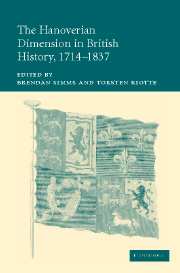Book contents
- Frontmatter
- Contents
- List of genealogical tables
- List of tables
- Notes on contributors
- Acknowledgements
- 1 Introduction. Hanover: the missing dimension
- 2 Hanoverian nexus: Walpole and the Electorate
- 3 Pitt and Hanover
- 4 George III and Hanover
- 5 The Hanoverian dimension in early nineteenth-century British politics
- 6 The end of the dynastic union, 1815–1837
- 7 The university of Göttingen and the Personal Union, 1737–1837
- 8 The confessional dimension
- 9 Hanover and the public sphere
- 10 Dynastic perspectives
- 11 British maritime strategy and Hanover 1714–1763
- 12 Hanover in mid-eighteenth-century Franco-British geopolitics
- 13 Hanover and British republicanism
- Index
10 - Dynastic perspectives
Published online by Cambridge University Press: 13 July 2009
- Frontmatter
- Contents
- List of genealogical tables
- List of tables
- Notes on contributors
- Acknowledgements
- 1 Introduction. Hanover: the missing dimension
- 2 Hanoverian nexus: Walpole and the Electorate
- 3 Pitt and Hanover
- 4 George III and Hanover
- 5 The Hanoverian dimension in early nineteenth-century British politics
- 6 The end of the dynastic union, 1815–1837
- 7 The university of Göttingen and the Personal Union, 1737–1837
- 8 The confessional dimension
- 9 Hanover and the public sphere
- 10 Dynastic perspectives
- 11 British maritime strategy and Hanover 1714–1763
- 12 Hanover in mid-eighteenth-century Franco-British geopolitics
- 13 Hanover and British republicanism
- Index
Summary
The Anglo-Hanoverian connection began partly, and ended solely, for dynastic reasons. After the Glorious Revolution Britain needed to preserve the protestant succession, the new parliamentary constitution, and strategic alliances against French support for the Jacobite claims. The failure of the protestant Stuart line in 1701 led to the succession being vested in the granddaughter of James I, Sophia, Dowager Electress of Hanover, and her protestant descendants. As well as these dynastic links, Hanover had been part of the grand alliance formed against France in 1689, and again during the War of the Spanish Succession. The link came to an end because Hanoverian succession law, favouring male over female descent wherever possible, meant the claims of Queen Victoria's oldest uncle Ernest duke of Cumberland took precedence there when she ascended the British throne. Political and strategic considerations were not significant: this was purely a family matter.
How can dynastic perspectives suggest an agenda for contemporary historical research? It is not a concept which has received much recent attention by academic Anglo-American historians dealing with the long eighteenth century, and there is virtually no recent historiography devoted to it, though it has been an integral strand to the revival of interest in court studies since the mid-1990s.
- Type
- Chapter
- Information
- The Hanoverian Dimension in British History, 1714–1837 , pp. 213 - 251Publisher: Cambridge University PressPrint publication year: 2007

